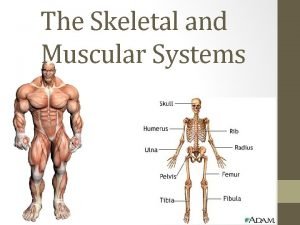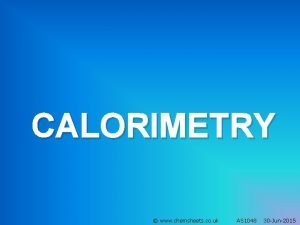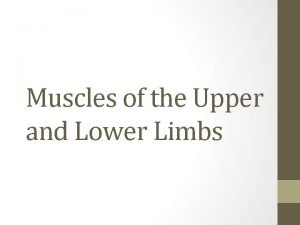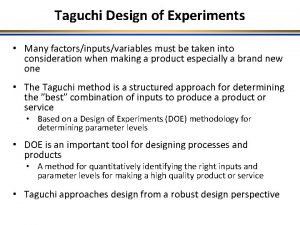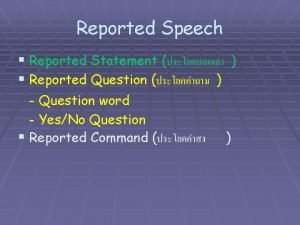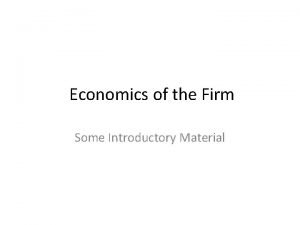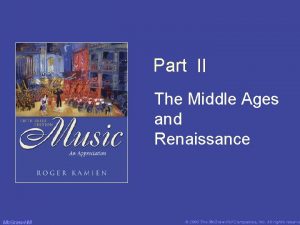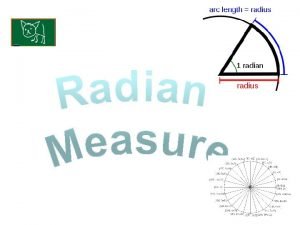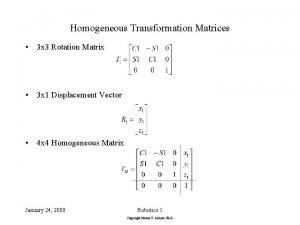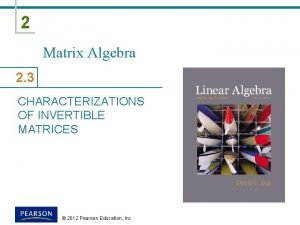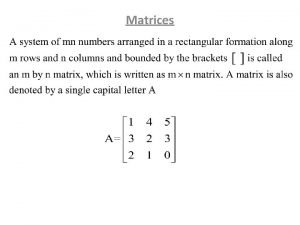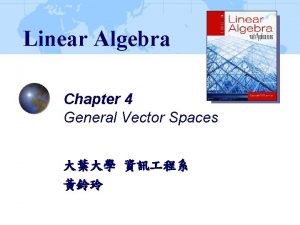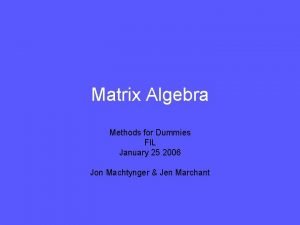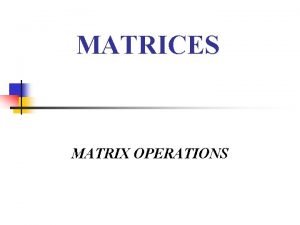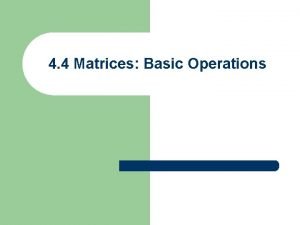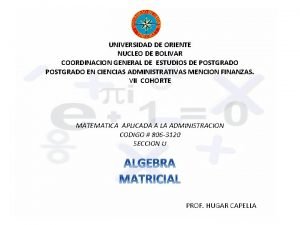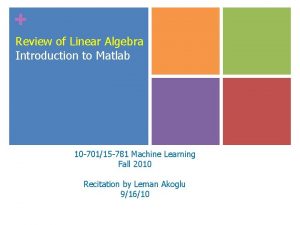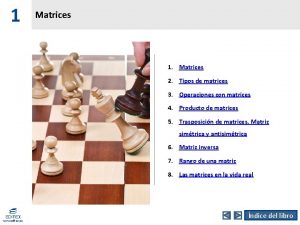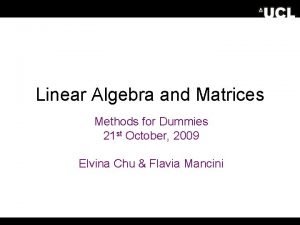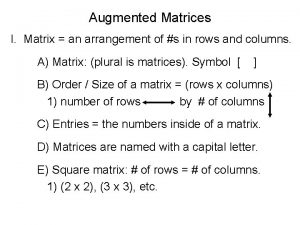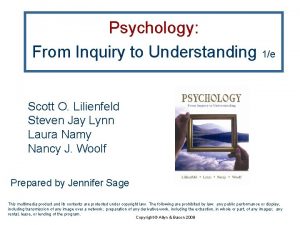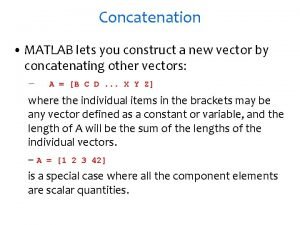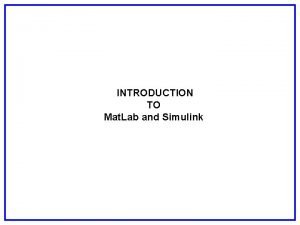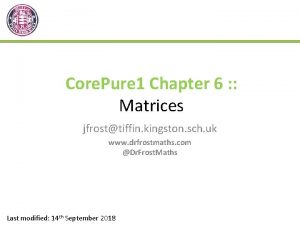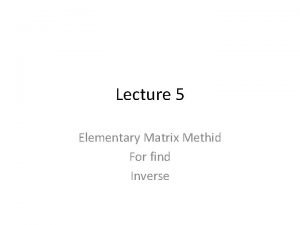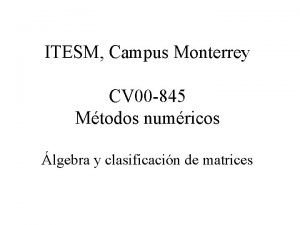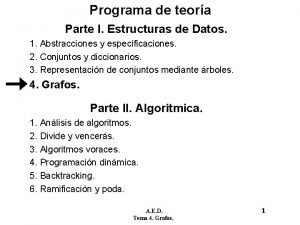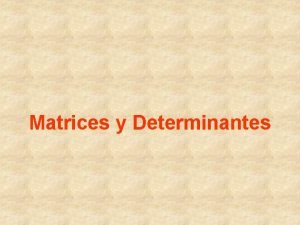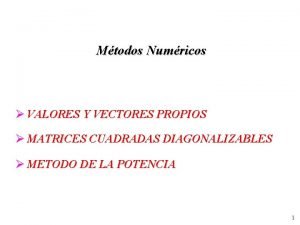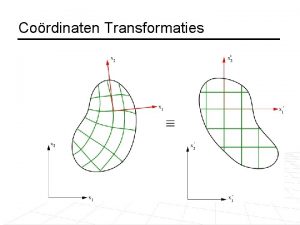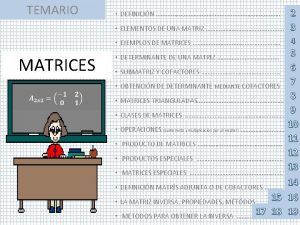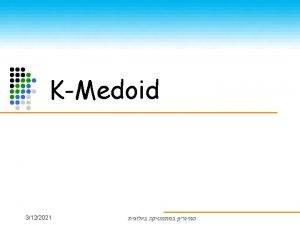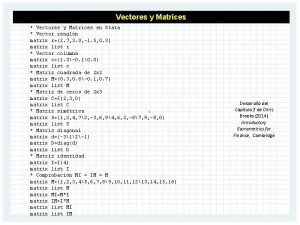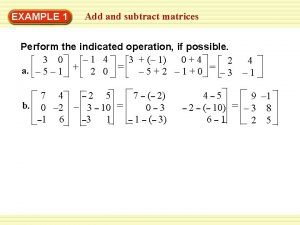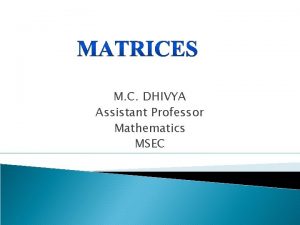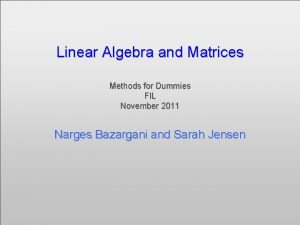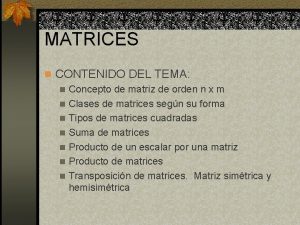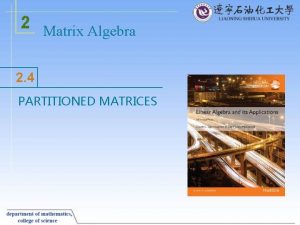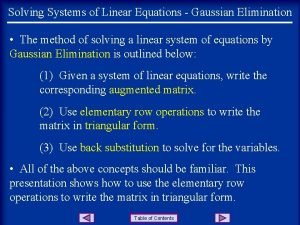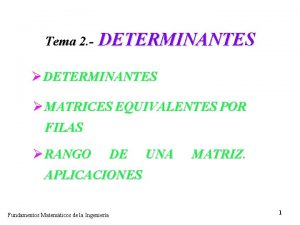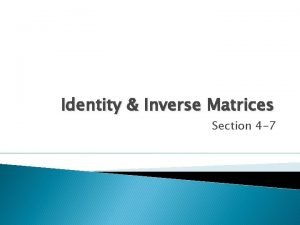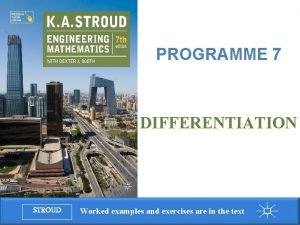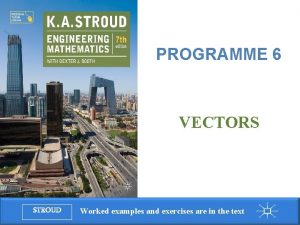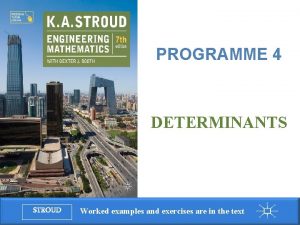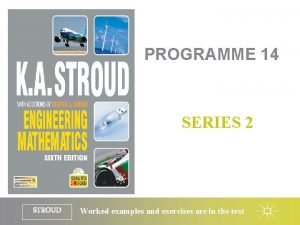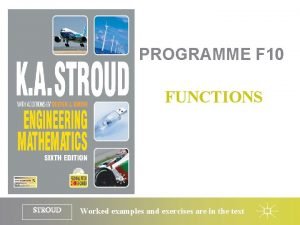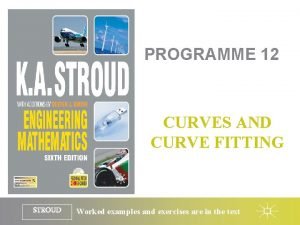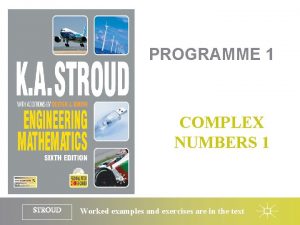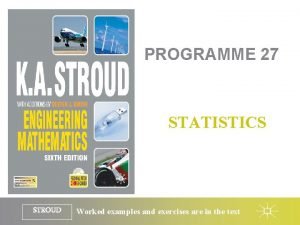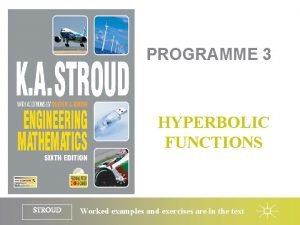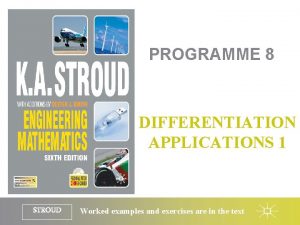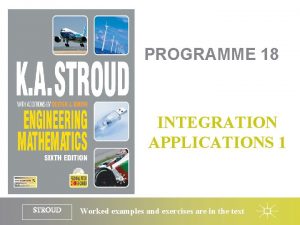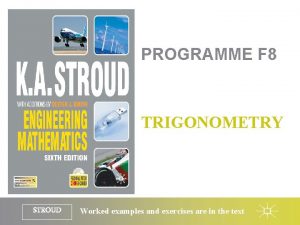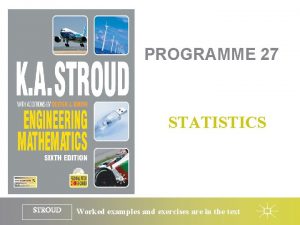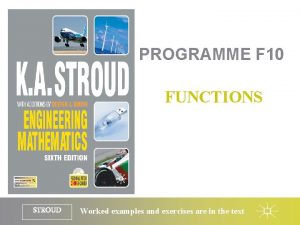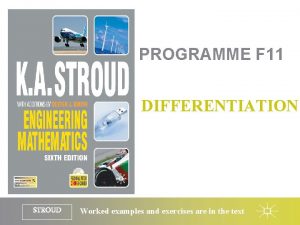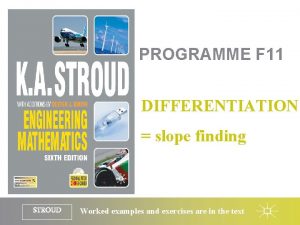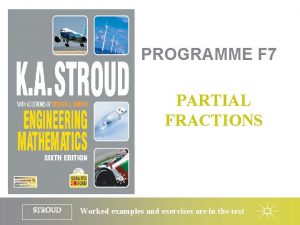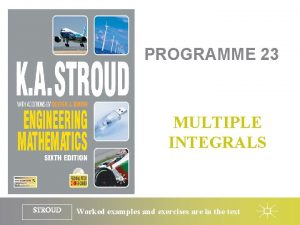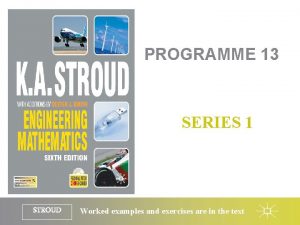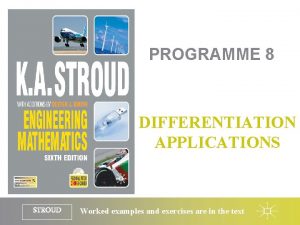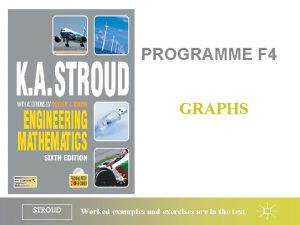Programme 5 Matrices PROGRAMME 5 MATRICES STROUD Worked



























































- Slides: 59

Programme 5: Matrices PROGRAMME 5 MATRICES STROUD Worked examples and exercises are in the text

Programme 5: Matrices – definitions Matrix notation Equal matrices Addition and subtraction of matrices Multiplication of matrices Transpose of a matrix Special matrices Determinant of a square matrix Inverse of a square matrix Solution of a set of linear equations Eigenvalues and eigenvectors STROUD Worked examples and exercises are in the text

Programme 5: Matrices – definitions Matrix notation Equal matrices Addition and subtraction of matrices Multiplication of matrices Transpose of a matrix Special matrices Determinant of a square matrix Inverse of a square matrix Solution of a set of linear equations Eigenvalues and eigenvectors STROUD Worked examples and exercises are in the text

Programme 5: Matrices – definitions A matrix is a set of real or complex numbers (called elements) arranged in rows and columns to form a rectangular array. A matrix having m rows and n columns is called an m × n matrix. For example: is a 2 × 3 matrix. STROUD Worked examples and exercises are in the text

Programme 5: Matrices – definitions Row matrix A row matrix consists of a single row. For example: Column matrix A column matrix consists of a single column. For example: STROUD Worked examples and exercises are in the text

Programme 5: Matrices – definitions Double suffix notation Each element of a matrix has its own address denoted by double suffices, the first indicating the row and the second indicating the column. For example, the elements of 3 × 4 matrix can be written as: STROUD Worked examples and exercises are in the text

Programme 5: Matrices – definitions Matrix notation Equal matrices Addition and subtraction of matrices Multiplication of matrices Transpose of a matrix Special matrices Determinant of a square matrix Inverse of a square matrix Solution of a set of linear equations Eigenvalues and eigenvectors STROUD Worked examples and exercises are in the text

Programme 5: Matrices – definitions Matrix notation Equal matrices Addition and subtraction of matrices Multiplication of matrices Transpose of a matrix Special matrices Determinant of a square matrix Inverse of a square matrix Solution of a set of linear equations Eigenvalues and eigenvectors STROUD Worked examples and exercises are in the text

Programme 5: Matrices Matrix notation Where there is no ambiguity a matrix can be represented by a single general element in brackets or by a capital letter in bold type. STROUD Worked examples and exercises are in the text

Programme 5: Matrices – definitions Matrix notation Equal matrices Addition and subtraction of matrices Multiplication of matrices Transpose of a matrix Special matrices Determinant of a square matrix Inverse of a square matrix Solution of a set of linear equations Eigenvalues and eigenvectors STROUD Worked examples and exercises are in the text

Programme 5: Matrices – definitions Matrix notation Equal matrices Addition and subtraction of matrices Multiplication of matrices Transpose of a matrix Special matrices Determinant of a square matrix Inverse of a square matrix Solution of a set of linear equations Eigenvalues and eigenvectors STROUD Worked examples and exercises are in the text

Programme 5: Matrices Equal matrices Two matrices are equal if corresponding elements throughout are equal. STROUD Worked examples and exercises are in the text

Programme 5: Matrices – definitions Matrix notation Equal matrices Addition and subtraction of matrices Multiplication of matrices Transpose of a matrix Special matrices Determinant of a square matrix Inverse of a square matrix Solution of a set of linear equations Eigenvalues and eigenvectors STROUD Worked examples and exercises are in the text

Programme 5: Matrices – definitions Matrix notation Equal matrices Addition and subtraction of matrices Multiplication of matrices Transpose of a matrix Special matrices Determinant of a square matrix Inverse of a square matrix Solution of a set of linear equations Eigenvalues and eigenvectors STROUD Worked examples and exercises are in the text

Programme 5: Matrices Addition and subtraction of matrices Two matrices are added (or subtracted) by adding (or subtracting) corresponding elements. For example: STROUD Worked examples and exercises are in the text

Programme 5: Matrices – definitions Matrix notation Equal matrices Addition and subtraction of matrices Multiplication of matrices Transpose of a matrix Special matrices Determinant of a square matrix Inverse of a square matrix Solution of a set of linear equations Eigenvalues and eigenvectors STROUD Worked examples and exercises are in the text

Programme 5: Matrices – definitions Matrix notation Equal matrices Addition and subtraction of matrices Multiplication of matrices Transpose of a matrix Special matrices Determinant of a square matrix Inverse of a square matrix Solution of a set of linear equations Eigenvalues and eigenvectors STROUD Worked examples and exercises are in the text

Programme 5: Matrices Multiplication of matrices Scalar multiplication Multiplication of two matrices STROUD Worked examples and exercises are in the text

Programme 5: Matrices Multiplication of matrices Scalar multiplication To multiply a matrix by a single number (a scalar), each individual element of the matrix is multiplied by that number. For example: That is: STROUD Worked examples and exercises are in the text

Programme 5: Matrices Multiplication of matrices Multiplication of two matrices Two matrices can only be multiplied when the number of columns in the first matrix equals the number of rows in the second matrix. The ijth element of the product matrix is obtained by multiplying each element in the ith row of the first matrix by the corresponding element in the jth column of the second matrix and the element products added. For example: STROUD Worked examples and exercises are in the text

Programme 5: Matrices Multiplication of matrices Multiplication of two matrices STROUD Worked examples and exercises are in the text

Programme 5: Matrices Multiplication of matrices Multiplication of two matrices STROUD Worked examples and exercises are in the text

Programme 5: Matrices – definitions Matrix notation Equal matrices Addition and subtraction of matrices Multiplication of matrices Transpose of a matrix Special matrices Determinant of a square matrix Inverse of a square matrix Solution of a set of linear equations Eigenvalues and eigenvectors STROUD Worked examples and exercises are in the text

Programme 5: Matrices – definitions Matrix notation Equal matrices Addition and subtraction of matrices Multiplication of matrices Transpose of a matrix Special matrices Determinant of a square matrix Inverse of a square matrix Solution of a set of linear equations Eigenvalues and eigenvectors STROUD Worked examples and exercises are in the text

Programme 5: Matrices Transpose of a matrix If a new matrix is formed by interchanging rows and columns the new matrix is called the transpose of the original matrix. For example, if: STROUD Worked examples and exercises are in the text

Programme 5: Matrices – definitions Matrix notation Equal matrices Addition and subtraction of matrices Multiplication of matrices Transpose of a matrix Special matrices Determinant of a square matrix Inverse of a square matrix Solution of a set of linear equations Eigenvalues and eigenvectors STROUD Worked examples and exercises are in the text

Programme 5: Matrices – definitions Matrix notation Equal matrices Addition and subtraction of matrices Multiplication of matrices Transpose of a matrix Special matrices Determinant of a square matrix Inverse of a square matrix Solution of a set of linear equations Eigenvalues and eigenvectors STROUD Worked examples and exercises are in the text

Programme 5: Matrices Special matrices Square matrix Diagonal matrix Unit matrix Null matrix STROUD Worked examples and exercises are in the text

Programme 5: Matrices Special matrices Square matrix A square matrix is of order m × m. A square matrix is symmetric if A square matrix is skew-symmetric if STROUD . For example: Worked examples and exercises are in the text

Programme 5: Matrices Special matrices Diagonal matrix A diagonal matrix is a square matrix with all elements zero except those on the leading diagonal. For example: STROUD Worked examples and exercises are in the text

Programme 5: Matrices Special matrices Unit matrix A unit matrix is a diagonal matrix with all elements on the leading diagonal being equal to unity. For example: The product of matrix A and the unit matrix is the matrix A: STROUD Worked examples and exercises are in the text

Programme 5: Matrices Special matrices Null matrix A null matrix is one whose elements are all zero. Notice that But that if STROUD we cannot deduce that or Worked examples and exercises are in the text

Programme 5: Matrices – definitions Matrix notation Equal matrices Addition and subtraction of matrices Multiplication of matrices Transpose of a matrix Special matrices Determinant of a square matrix Inverse of a square matrix Solution of a set of linear equations Eigenvalues and eigenvectors STROUD Worked examples and exercises are in the text

Programme 5: Matrices – definitions Matrix notation Equal matrices Addition and subtraction of matrices Multiplication of matrices Transpose of a matrix Special matrices Determinant of a square matrix Inverse of a square matrix Solution of a set of linear equations Eigenvalues and eigenvectors STROUD Worked examples and exercises are in the text

Programme 5: Matrices Determinant of a square matrix Singular matrix Cofactors Adjoint of a square matrix STROUD Worked examples and exercises are in the text

Programme 5: Matrices Determinant of a square matrix Singular matrix Every square matrix has its associated determinant. For example, the determinant of The determinant of a matrix is equal to the determinant of its transpose. A matrix whose determinant is zero is called a singular matrix. STROUD Worked examples and exercises are in the text

Programme 5: Matrices Determinant of a square matrix Cofactors Each element of a square matrix has a minor which is the value of the determinant obtained from the matrix after eliminating the ith row and jth column to which the element is common. The cofactor of element STROUD is then given as the minor of multiplied by Worked examples and exercises are in the text

Programme 5: Matrices Determinant of a square matrix Adjoint of a square matrix Let square matrix C be constructed from the square matrix A where the elements of C are the respective cofactors of the elements of A so that if: Then the transpose of C is called the adjoint of A, denoted by adj. A. STROUD Worked examples and exercises are in the text

Programme 5: Matrices – definitions Matrix notation Equal matrices Addition and subtraction of matrices Multiplication of matrices Transpose of a matrix Special matrices Determinant of a square matrix Inverse of a square matrix Solution of a set of linear equations Eigenvalues and eigenvectors STROUD Worked examples and exercises are in the text

Programme 5: Matrices – definitions Matrix notation Equal matrices Addition and subtraction of matrices Multiplication of matrices Transpose of a matrix Special matrices Determinant of a square matrix Inverse of a square matrix Solution of a set of linear equations Eigenvalues and eigenvectors STROUD Worked examples and exercises are in the text

Programme 5: Matrices Inverse of a square matrix If each element of the adjoint of a square matrix A is divided by the determinant of A then the resulting matrix is called the inverse of A, denoted by A-1. Note: if det A = 0 then the inverse does not exist STROUD Worked examples and exercises are in the text

Programme 5: Matrices Inverse of a square matrix Product of a square matrix and its inverse The product of a square matrix and its inverse is the unit matrix: STROUD Worked examples and exercises are in the text

Programme 5: Matrices – definitions Matrix notation Equal matrices Addition and subtraction of matrices Multiplication of matrices Transpose of a matrix Special matrices Determinant of a square matrix Inverse of a square matrix Solution of a set of linear equations Eigenvalues and eigenvectors STROUD Worked examples and exercises are in the text

Programme 5: Matrices – definitions Matrix notation Equal matrices Addition and subtraction of matrices Multiplication of matrices Transpose of a matrix Special matrices Determinant of a square matrix Inverse of a square matrix Solution of a set of linear equations Eigenvalues and eigenvectors STROUD Worked examples and exercises are in the text

Programme 5: Matrices Solution of a set of linear equations The set of n simultaneous linear equations in n unknowns can be written in matrix form as: STROUD Worked examples and exercises are in the text

Programme 5: Matrices Solution of a set of linear equations Since: The solution is then: STROUD Worked examples and exercises are in the text

Programme 5: Matrices Solution of a set of linear equations Gaussian elimination method for solving a set of linear equations Given: Create the augmented matrix B, where: STROUD Worked examples and exercises are in the text

Programme 5: Matrices Solution of a set of linear equations Gaussian elimination method for solving a set of linear equations Eliminate the elements other than a 11 from the first column by subtracting a 21/a 11 times the first row from the second row, a 31/a 11 times the first row from the third row, etc. This gives a new matrix of the form: STROUD Worked examples and exercises are in the text

Programme 5: Matrices Solution of a set of linear equations Gaussian elimination method for solving a set of linear equations This process is repeated to eliminate the ci 2 from the third and subsequent rows until a matrix of the following form is arrived at: STROUD Worked examples and exercises are in the text

Programme 5: Matrices Solution of a set of linear equations Gaussian elimination method for solving a set of linear equations From this augmented matrix we revert to the product: STROUD Worked examples and exercises are in the text

Programme 5: Matrices Solution of a set of linear equations Gaussian elimination method for solving a set of linear equations From this product the solution is derived by working backwards from the bottom starting with: STROUD Worked examples and exercises are in the text

Programme 5: Matrices – definitions Matrix notation Equal matrices Addition and subtraction of matrices Multiplication of matrices Transpose of a matrix Special matrices Determinant of a square matrix Inverse of a square matrix Solution of a set of linear equations Eigenvalues and eigenvectors STROUD Worked examples and exercises are in the text

Programme 5: Matrices – definitions Matrix notation Equal matrices Addition and subtraction of matrices Multiplication of matrices Transpose of a matrix Special matrices Determinant of a square matrix Inverse of a square matrix Solution of a set of linear equations Eigenvalues and eigenvectors STROUD Worked examples and exercises are in the text

Programme 5: Matrices Eigenvalues and eigenvectors Equations of the form: where A is a square matrix and is a number (scalar) have non-trivial solutions (x 0) for x called eigenvectors or characteristic vectors of A. The corresponding values of are called eigenvalues, characteristic values or latent roots of A. STROUD Worked examples and exercises are in the text

Programme 5: Matrices Eigenvalues and eigenvectors Expressed as a set of separate equations: That is: STROUD Worked examples and exercises are in the text

Programme 5: Matrices Eigenvalues and eigenvectors These can be rewritten as: That is: Which means that, for non-trivial solutions: STROUD Worked examples and exercises are in the text

Programme 5: Matrices Eigenvalues and eigenvectors Eigenvalues To find the eigenvalues of: solve the characteristic equation: That is: This gives eigenvalues STROUD Worked examples and exercises are in the text

Programme 5: Matrices Eigenvalues and eigenvectors Eigenvectors To find the eigenvectors of For the eigenvalues STROUD = 1 and solve the equation =5 Worked examples and exercises are in the text

Programme 5: Matrices Learning outcomes üDefine a matrix üUnderstand what is meant by the equality of two matrices üAdd and subtract two matrices üMultiply a matrix by a scalar and multiply two matrices together üObtain the transpose of a matrix üRecognize the special types of matrix üObtain the determinant, cofactors and adjoint of a square matrix üObtain the inverse of a non-singular matrix üUse matrices to solve a set of linear equations using inverse matrices üUse the Gaussian elimination method to solve a set of linear equations üEvaluate eigenvalues and eigenvectors STROUD Worked examples and exercises are in the text
 Nick stroud
Nick stroud She worked hard. she made herself ill
She worked hard. she made herself ill I stumbled in his hob-nailed wake,
I stumbled in his hob-nailed wake, How the body works answer key
How the body works answer key Calorimetry 3 chemsheets answers
Calorimetry 3 chemsheets answers Prime mover of the arm
Prime mover of the arm Guillaume de machaut worked primarily in
Guillaume de machaut worked primarily in Dbq outline
Dbq outline Taguchi design of experiments
Taguchi design of experiments Were reported speech
Were reported speech Type 3 conditionals
Type 3 conditionals How feudalism worked
How feudalism worked Worked out
Worked out Josquin desprez was a contemporary of
Josquin desprez was a contemporary of Difference between reservoir routing and channel routing
Difference between reservoir routing and channel routing Area of a sector radians
Area of a sector radians Essays that worked johns hopkins
Essays that worked johns hopkins Complex numbers as matrices
Complex numbers as matrices Homogenous transformation matrices
Homogenous transformation matrices Superposition of matrices
Superposition of matrices Invertible
Invertible Product of orthogonal matrices
Product of orthogonal matrices Linear algebra
Linear algebra Matrix for dummies
Matrix for dummies Operations with matrices
Operations with matrices Matrices in google docs
Matrices in google docs Subtraction of matrices definition
Subtraction of matrices definition Un contratista dispone de 5000 horas hombre
Un contratista dispone de 5000 horas hombre Linearly independen
Linearly independen Matrices
Matrices Linear algebra for dummies
Linear algebra for dummies Matrices on ti 84
Matrices on ti 84 Average iq by job
Average iq by job Concatenation matlab
Concatenation matlab Simulink matrix multiplication
Simulink matrix multiplication Dr frost matrices
Dr frost matrices Elementary matrices
Elementary matrices Clasificacion de matrices
Clasificacion de matrices Unit 1 algebra basics homework 6 matrices
Unit 1 algebra basics homework 6 matrices Matrices de adyacencia
Matrices de adyacencia Igualdad matrices
Igualdad matrices Valor propio dominante
Valor propio dominante Coördinatentransformatie
Coördinatentransformatie Matrices diagonal
Matrices diagonal Leslie matrices
Leslie matrices Distance matrices
Distance matrices Sistemas de ecuaciones
Sistemas de ecuaciones Adding matrices with different dimensions
Adding matrices with different dimensions Stata vector
Stata vector Ellp matrices
Ellp matrices Subtract matrices calculator
Subtract matrices calculator Multiplying matrices
Multiplying matrices Linear algebra for dummies
Linear algebra for dummies Con las matrices n
Con las matrices n Power of a matrix
Power of a matrix Partitioned matrix example
Partitioned matrix example Gauss-jordan elimination
Gauss-jordan elimination Sentence writing fluency wj iv
Sentence writing fluency wj iv Determinantes equivalentes
Determinantes equivalentes Identity matrix
Identity matrix



